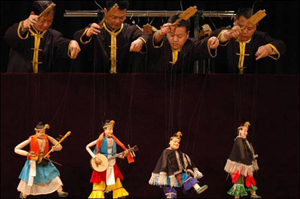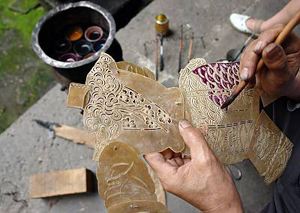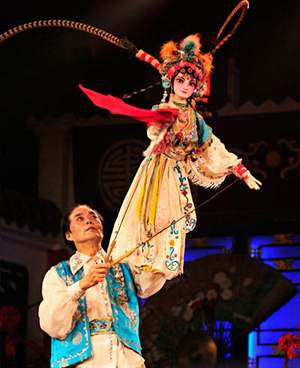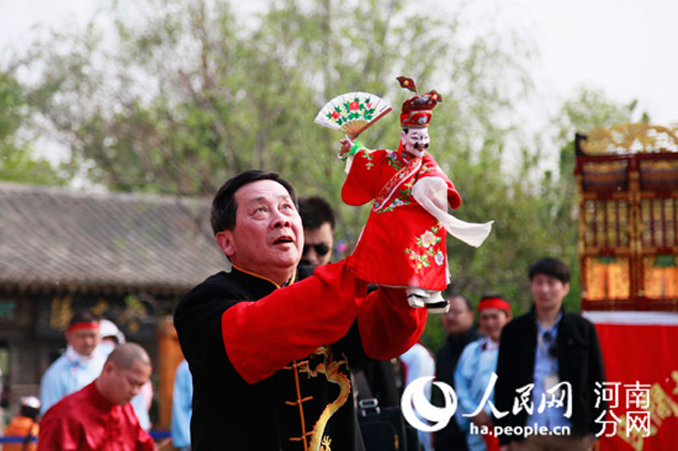Written by: Hang Jian and Guo Qiuhui
Posted on: May 27, 2020 | 
Shadow Puppets
In 1979, a puppet was unearthed from a Han Dynasty tomb in Laixi of Shandong province. The puppet, 193 centimeters in height and composed of thirteen articulated parts, can be made to sit, stand or kneel. The discovery indicates that the function of puppets at that time had shifted from being a funerary object to a thing for entertainment, which foretold the birth of puppet show.
 |
Marionnettes |
In the classic writing Tong dian (Laws and Rules recorded) written by Du You of the Tang Dynasty, there is a short passage: “In the last years of Han Dynasty, puppets began to be used for entertainment on grand occasions. In earlier times, they were used only at funerals.” By the Sui Dynasty, the embryonic form of puppet show had taken shape. Even scenes from traditional opera could be performed with puppets. From the Tang Dynasty, puppetry grew mature day by day. The murals and poems of the prosperous period of Tang Dynasty stored in Cave No.31 of Mogao Grottos in Dunhuang, Gansu Province indicate that different categories of puppets including glove puppets, marionettes and rod-hand puppets had already appeared.
The puppet show came to its prime in the dynasties of Song and Yuan. Puppet show troupes mushroomed in Song Dynasty, offering performances pertaining to various subject matters. From Yuan Dynasty, puppets could be manipulated to act vividly the gamut of human emotions-happiness, grief and joy.
 |
From the Ming down to the Qing Dynasty, diversified schools of puppet show spread all over the country, each with local flavor of its own. Take the marionette show in Quanzhou of Fujian Province for an example. The puppets were exquisitely made and manipulated with superb skills. A single puppet figure could be controlled by as many as twenty up to thirty strings. In Qing Dynasty, rod puppet show prevailed among which the Beijing rod puppet show was played in the royal court as a special-form Peking opera.
By traditional puppet making craft, the head and limbs of puppet figures were made of camphorwood, which is sweet smelling and lustrous especially after you have it polished. A dozen steps are needed in the working procedure including the choosing of appropriate material, carving both rough and meticulous, papering, polishing, coating with clay, applying powder, putting on facial makeup and coating lacquer.
 |
Rod puppet |
The puppet show also features local characteristics of the region, by manipulating skill, designed figures and particular stage art. Of all the different varieties of puppet show, the rod puppet show is the most popular. The rod puppet show falls into three types: large-sized, medium-sized and small-sized, in accordance with the performing style and figure designs. The small-sized puppets, also known as refined puppets, about 40 centimeters in length, are exquisite, precise in movements and adept at playing both civil and martial roles. Large-sized puppets are 1.4 meters long, five kilos heavy, can play putting on clothes, lighting a fire,
kowtowing, wielding a sword, etc.. The puppets of the statue similar to a human being often perform together with "human puppets" played by kids, in a bid to have an artistic effect of "mixing the false with the real" and "false and true at the same time. " The rod puppets are worked by a "life-rod" connecting the puppet head and two "hand rods" joining the hands of the puppet. The puppet is ingeniously designed and manipulated so that its eyes and mouth are movable.
Glove puppets, also called "palm puppets," are worked by fitting on the hand of the performer. The glove puppet show is most prevalent in Quanzhou of Fujian Province. The puppet is about 30 centimeters in length, consisting of a head, a trunk and clothes. The head is made of camphorwood with gears installed to control the movement of eyes and mouth. The performer's index finger is used to manipulate the puppet head, the middle finger and the thumb and the two puppet hands respectively. The glove puppet show is characterized by various movements, both precise and nimble including movements that require superior skills such as unfolding a fan, changing clothes, performing sword-dance, fighting with a weapon, jumping through a window, etc.
 |
Hand puppet |
A marionette is a joint puppet moved by strings. It is composed of the head, the trunk, limbs and manipulating strings, some sixty centimeters in length. Its head is carved out of camphorwood, Chinese linden or willow wood, with gears to control facial expressions. Hands are of two types: the martial type and the civil type. The martial-type hands are manipulated to wield spear and cudgels; the civil type wave fans or raise wine cups. The puppet feet can be bare, booted, or can be in the shape of females.
The iron wire puppet show circulated in the western Fujian and eastern Guangdong region, took shape in the last days of Qing Dynasty and enjoyed popularity for a period of time. The most distinct feature is that it maintains the manipulating skills of the shadow play. The operators working in a transparent case, use iron wire to accomplish each movement. The manipulating rod is called iron branch. The puppet is one to one and a half meters in length made of paulownia wood, with paper hands and wooden feet. The head is made of red clay, after being baked and then coated with waterproof coloring. Different types of facial make-up indicating personalities and characters are applied. The operators, sitting or standing, manipulate the puppet from behind.
You may also like: